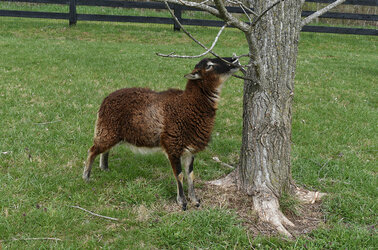yeah the modern sheep is the result of breeding mouflons for maximum fleece yield over a long time.
before that, they looked like this:
View attachment 3081973
View attachment 3081974
Right, the wild mouflon is to the domestic sheep as wolves are to dogs. And just like some people have deliberately backcrossed dogs to wolves, so some people have backcrossed domestic sheep to mouflons. The miniature breed that is the modern Soay sheep is one such cross; basically, they are smaller, slightly friendlier, somewhat fluffier mouflons.
There's some crazy woman in Kentucky who actually keeps these half-wild sheep as pets (along with a few Shetland miniature sheep). Just look at this lovely mouflon coloration on this Soay sheep here! She's beautiful:

Here name is Mira, short for Baby Miracle. In an earlier post in this thread, I mentioned that I suspected that sheep could have a form of autism.
Things like this are part of the reason why. She is more interested in interacting with inanimate objects (sticks and rocks) than other sheep, she's quite bad-tempered, and if offended she'll hold a grudge for a week. Also she has no maternal instincts, and her only lamb, Angel, had to be bottle-fed (like Mira herself; the crazy sheep lady took the hint and didn't try breeding the line any further). Angel is even more bad-tempered and is crazy-aggressive. The two bottle lambs would fight over the attention of their human mother.
This post mentions that she had to bribe these very wild and troublesome sheep with immense amounts of crunchies (Corn Chex cereal), which like every cereal you'll find these days contains substantial amounts of added sugar. Which over time can cause gut dysbiosis with soaring populations of Candida genus gut yeast, at least in humans, and autistic humans in particular have very high levels of Candida. And in humans, this condition causes poor absorption of various nutrients including zinc. Which autistic people are low in, because of their chronic Candida gut infection. And one of the symptoms of zinc depletion is loss of the sense of smell and taste. Guess what sense a mother sheep uses to bond to her newborn lamb? Yes, it's smell. When the lamb is born, it is covered in amniotic fluid, which the mother's high oxytocin levels from the birth cause her to be attracted to (normally the smell repulses sheep) and lick off. When she does this, she gets a really really good whiff of the new lamb's scent, right when her sky-high levels of oxytocin have primed her to bond emotionally. This gets her to let the lamb nurse, and once she lets the baby nurse then it will further strengthen the bond and the lamb, in turn, will start to recognize the ewe as its mother.
The social symptoms of autism in humans are caused by a Clostridia-genus gut infection that is able to opportunistically exploit the weakening of the gut's defenses caused by the Candida. The Clostridia then secretes excess amounts of propionic acid which poisons the cerebellum, causing problems with motor skills, emotional regulation, and socializing. Well, this is part of the issue anyway; I have found out that irritable bowel syndrome also involves Clostridia infection, but without Candida, full autism does not manifest, and
here I explain about the neurological consequences of the copper/zinc imbalance caused by the Candida infection. I now believe that the issue is a malevolent synergistic effect where the excess copper and excess propionic acid from these two gut microbes both impair the cerebellum more than either alone. I don't know of any reason why this would affect a sheep any differently. If this sheep were a person, I'd recommend that she take zinc, high-dose taurine, N-acetyl-cysteine (NAC), vitamin B6, and niacin.


